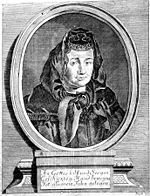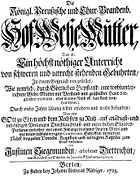
Justine Siegemund
Encyclopedia

Germany
Germany , officially the Federal Republic of Germany , is a federal parliamentary republic in Europe. The country consists of 16 states while the capital and largest city is Berlin. Germany covers an area of 357,021 km2 and has a largely temperate seasonal climate...
midwife whose Court Midwife (1690) was the first female-authored German medical text.
Early life
Strikingly, Siegemund herself was childless, which should have technically disqualified her from her profession, as only childbearing midwives were supposed to be able to practice. Had that been the case, however, seventeenth century EuropeEurope
Europe is, by convention, one of the world's seven continents. Comprising the westernmost peninsula of Eurasia, Europe is generally 'divided' from Asia to its east by the watershed divides of the Ural and Caucasus Mountains, the Ural River, the Caspian and Black Seas, and the waterways connecting...
would have lost a consummate professional in her discipline.
She was born the daughter of Elias Diettrich, a Lutheran minister, in Rohnstock, Silesia
Silesia
Silesia is a historical region of Central Europe located mostly in Poland, with smaller parts also in the Czech Republic, and Germany.Silesia is rich in mineral and natural resources, and includes several important industrial areas. Silesia's largest city and historical capital is Wrocław...
(today Roztoka
Roztoka, Lower Silesian Voivodeship
Roztoka is a village in the administrative district of Gmina Dobromierz, within Świdnica County, Lower Silesian Voivodeship, in south-western Poland. Prior to 1945 it was in Germany....
) on December 26, 1636. Her father died in 1650, when she was aged fourteen. In 1655, she married Christian Siegemund, an accountant, but the marriage was childless. However, it lasted for forty-two years, and Christian Siegemund provided considerable support to his wife during her professional career, although they may have lived apart from 1673.
Early Career: 1656-1672
At twenty, Justine Siegemund suffered considerably at the hand of incompetent midwives who wrongly assumed that she was pregnant. Her experience motivated her to educate herself about obstetrics, and she practiced herself for the first time in 1659, when she was asked to assist a case of obstructed labour related to a misplaced infant arm. Until 1671, she provided free midwifery services to peasant and poor women in her local area, although she also gradually diversified her client base to include women from merchant and noble families.Professional Midwife: 1672-1690

His groundless allegations did not affect Siegemund's professional employment opportunities, and in 1683 she was named the "city midwife" of Lignitz. Her expertise and dexterity caught the attention of Frederick William, Elector of Brandenburg
Frederick William, Elector of Brandenburg
|align=right|Frederick William was Elector of Brandenburg and Duke of Prussia – and thus ruler of Brandenburg-Prussia – from 1640 until his death. A member of the House of Hohenzollern, he is popularly known as the "Great Elector" because of his military and political prowess...
who appointed her as his court midwife termed the „Chur-Brandenburgische Hof-Wehemutter“ in Berlin
Berlin
Berlin is the capital city of Germany and is one of the 16 states of Germany. With a population of 3.45 million people, Berlin is Germany's largest city. It is the second most populous city proper and the seventh most populous urban area in the European Union...
in 1701. She also served as royal midwife for Frederick III
Frederick I of Prussia
Frederick I , of the Hohenzollern dynasty, was Elector of Brandenburg and Duke of Prussia in personal union . The latter function he upgraded to royalty, becoming the first King in Prussia . From 1707 he was in personal union the sovereign prince of the Principality of Neuchâtel...
's sister Marie-Amalie, Duchess of Saxony-Zeitz, and delivered four of her children. At the court of August the Strong, she assisted Saxon Electress Eberhardine
Christiane Eberhardine of Brandenburg-Bayreuth
Christiane Eberhardine of Brandenburg-Bayreuth was Electress of Saxony from 1694 to 1727 and titular Queen of the Polish–Lithuanian Commonwealth from 1697 to 1727 as the wife of Augustus II the Strong. Not once throughout the whole of her thirty-year queenship did she set foot in Poland, instead...
to give birth to her son, Frederick August II (1696). At the same time, she attended other births within the Berlin area.
While in the Netherlands
Netherlands
The Netherlands is a constituent country of the Kingdom of the Netherlands, located mainly in North-West Europe and with several islands in the Caribbean. Mainland Netherlands borders the North Sea to the north and west, Belgium to the south, and Germany to the east, and shares maritime borders...
, Mary II of Orange (1662-1694) suggested that Siegemund should author a textbook training manual for midwives. Siegemund had probably already started to compile the Court Midwife, however.
Siegemund rarely used early pharmaceuticals or surgical instruments within her practice. By the time that she died on November 10, 1705 in Berlin, Justine Siegemund had birthed almost six thousand two hundred infants, according to the Berlin deacon that presided over her funeral.
The Court Midwife (1690)

Frankfurt (Oder)
Frankfurt is a town in Brandenburg, Germany, located on the Oder River, on the German-Polish border directly opposite the town of Słubice which was a part of Frankfurt until 1945. At the end of the 1980s it reached a population peak with more than 87,000 inhabitants...
, and submitted her draft manual to the Frankfurt on Oder medical faculty, which approved her medical documentation. She had incorporated embryological and anatomical engravings from Regnier de Graaf
Regnier de Graaf
Regnier de Graaf, Dutch spelling Reinier de Graaf or latinized Reijnerus de Graeff was a Dutch physician and anatomist who made key discoveries in reproductive biology. His first name is often spelled Reinier or Reynier.-Biography:De Graaf was born in Schoonhoven and perhaps a relative to the De...
(1641-1673) and Govard Bidloo (1649-1713), which enhanced its practical utility. From April to June 1689, she protected her intellectual property stake in the volume through gaining printing privileges from the Electors of Brandenburg
Brandenburg
Brandenburg is one of the sixteen federal-states of Germany. It lies in the east of the country and is one of the new federal states that were re-created in 1990 upon the reunification of the former West Germany and East Germany. The capital is Potsdam...
and Saxony
Saxony
The Free State of Saxony is a landlocked state of Germany, contingent with Brandenburg, Saxony Anhalt, Thuringia, Bavaria, the Czech Republic and Poland. It is the tenth-largest German state in area, with of Germany's sixteen states....
, as well as the Holy Roman Emperor
Holy Roman Emperor
The Holy Roman Emperor is a term used by historians to denote a medieval ruler who, as German King, had also received the title of "Emperor of the Romans" from the Pope...
.
In Leipzig
Leipzig
Leipzig Leipzig has always been a trade city, situated during the time of the Holy Roman Empire at the intersection of the Via Regia and Via Imperii, two important trade routes. At one time, Leipzig was one of the major European centres of learning and culture in fields such as music and publishing...
, she had to endure yet another bout of male professional jealousy when Andreas Petermann (1649-1703) charged her with similar offences to those that Kerger had already advanced, but given his own comparative professional inexperience, Siegemund once again was able to surmount this challenge to her professional reputation.
Based on careful notes that she had made during her deliveries
Childbirth
Childbirth is the culmination of a human pregnancy or gestation period with the birth of one or more newborn infants from a woman's uterus...
she published an authoritative obstetrical text titled the Court Midwife (actually Die Kgl. Preußische und Chur-Brandenburgische Hof-Wehemutter) in 1690. It discusses its topics in the form of a dialogue
Dialogue
Dialogue is a literary and theatrical form consisting of a written or spoken conversational exchange between two or more people....
between Justine (herself) and Christina, a pupil. The Court Midwife was systematic and evidence-based in its presentation of possible childbirth complications, including problems like poor presentations, umbilical cord problems, and placenta previa and their management. In the textbook Siegmundin presented a solution to the delivery of a shoulder presentation
Shoulder presentation
A shoulder presentation refers to a malpresentation at childbirth where the baby is in a transverse lie , thus the leading part is an arm, shoulder, or the trunk...
, in those days often catastrophic situation leading to the death of the baby and potentially the mother. She worked out a two-handed intervention to rotate the baby in the uterus securing one extremity by a sling. She also is credited (along with François Mauriceau
François Mauriceau
François Mauriceau was a French obstetrician from Paris. He received his training in obstetrics at the Hôtel-Dieu.Mauriceau was a leading obstetrician in 17th century Europe...
) of finding a method to deal with a hemorrhaging placenta previa by puncturing the amniotic sac.
After Siegemund's death, the Court Midwife went through numerous republications, including Berlin
Berlin
Berlin is the capital city of Germany and is one of the 16 states of Germany. With a population of 3.45 million people, Berlin is Germany's largest city. It is the second most populous city proper and the seventh most populous urban area in the European Union...
(1708), Leipzig (1715,1724), with modifications that included corroborative male gynecological citations and accounts of the Kerger and Petermann cases when it was republished in 1741, 1752 and 1756.

